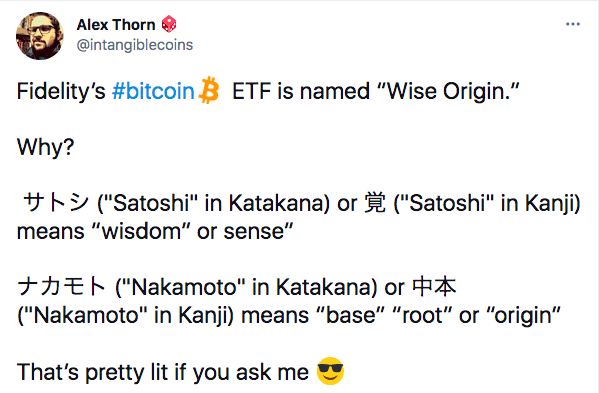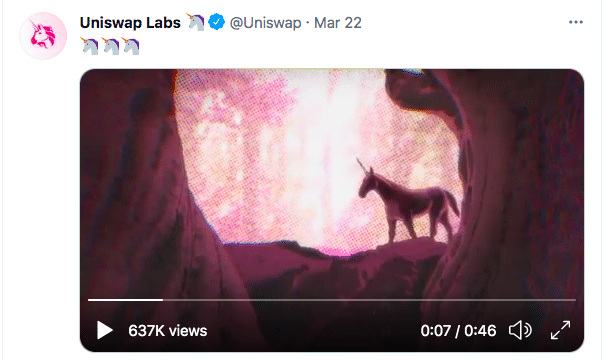PLUS: What you need to know about $COIN
The SEC received a bitcoin ETF application from Fidelity this week, marking the sixth such filing within the U.S. For a brief second, it also seemed Goldman Sachs filed too, but, as it was later clarified, Goldman only filed a note that may give them exposure to crypto through the Ark Innovation ETF. Continuing on the regulatory news trend, FATF released new draft guidance that, if approved, would make substantial changes to how NFTs and DeFi apps are treated by regulatory bodies.
Meanwhile, Coinbase continued its trek towards a direct listing. The exchange made a few different headlines this week after hosting a virtual AMA on Reddit and getting fined by the CFTC.
Tesla was very popular on Crypto Twitter after announcing a new Pay By Bitcoin feature on Wednesday. Or, as tweeted by Blockfolio:

The Ethereum ecosystem also had an interesting week. The long-awaited Uniswap v3 plan was released, leading to “Uniswap” Google searches almost reaching an all-time high. However, the UNI price has since dropped below $30, which could be a sign of displeasure with v3, or it might just be getting dragged down with the rest of the crypto market. NFTs, as usual, produced a few unique stories. Both the New York Times and Time Magazine published content as NFTs, while Jack Dorsey and Beeple swapped their Ethereum payments for a different form of money.
On Unchained, two registered investment advisors, Ric Edelman and Matthew Kolesky, dissect all the ways in which financial advisors, who control $5 trillion in investor wealth, are both resistant to investing in crypto and unable to. On Unconfirmed, Miami Mayor Francis Suarez discusses the potential FTX sponsorship of Miami’s basketball arena, why he believes governments will transact in crypto instead of fiat someday, and how he reconciles Bitcoin’s environmental impact against the potential effects of climate change on Miami.
Listen to the Latest Episode of Unchained
Financial Advisors Control $5 Trillion in Investor Wealth. Are They Buying Bitcoin?Ric Edelman, founder of Edelman Financial Engines, and Matthew Kolesky, president at Arbor Capital, discuss the state of Bitcoin adoption amongst financial advisors, who control $5 trillion in investor wealth.
Listen to the Latest Episode of Unconfirmed
Miami Mayor Francis Suarez talks about how Miami plans to be the crypto capital of the world.
Thank you to our sponsors!
Download the Crypto.com app and get $25 with the code “Laura”:
Check out InterPop, a superteam redefining the future of NTFs and fandom!
This Week’s Crypto News…
Fidelity Files for a Bitcoin ETF
An affiliate of Fidelity filed for a bitcoin ETF with the U.S. Securities and Exchange Commission on Wednesday. The proposed ETF, notes the application, will “provide direct exposure to bitcoin” and track the price of BTC through Fidelity’s in-house bitcoin price index, which adjusts for the trust’s expenses. Fidelity Digital Assets will custody the underlying bitcoin. Fidelity’s ETF will be named the “Wise Origin Bitcoin Trust,” — a subtle nod to Bitcoin’s pseudonymous creator. On Twitter, Alex Thorn, head of firmwide research at Galaxy Digital, pointed out that, in Japanese, Satoshi means “wisdom,” and Nakamoto means “origin.”

In a statement to The Block, a Fidelity spokesperson expounded on the filing, saying, “The digital assets ecosystem has grown significantly in recent years, creating an even more robust marketplace for investors and accelerating demand among institutions. An increasingly wide range of investors seeking access to bitcoin has underscored the need for a more diversified set of products offering exposure to digital assets.”
Fidelity’s entrance into the bitcoin ETF race comes right on the heels of similar efforts by VanEck, Valkyrie, NYDIG, WisdomTree, and First Advisors/SkyBridge.
Coinbase’s Direct Listing Draws Scrutiny to the Firm’s Prospects, Brian Armstrong’s Net Worth and Customer Service
Mario Gabriele, founder of tech newsletter The Generalist, along with well-known crypto analysts such as Jill Carlson, Ryan Todd, and Katherine Wu, wrote up a comprehensive piece on the paradoxes of Coinbase as a centralized exchange championing the rise of decentralization. The article is too long to summarize here, but I recommend it for those looking for a thorough analysis on Coinbase ahead of its direct listing. Some choice highlights include:
- correlation between Coinbase revenue growth and Bitcoin price has been around 70% for the past few years
- institutional trading made up 64% of Coinbase’s trading volume while only accounting for 5% of revenue
- transaction fees made up 86% of Coinbase’s revenue in 2020
CNBC reports the much anticipated Coinbase direct listing is poised to make co-founder and CEO Brian Armstrong a very wealthy man. At the latest valuation, Armstrong’s stake in the exchange is worth $13.6 billion — which would leave him in the company of recent tech founders like Zoom’s Eric Yuan ($16 billion), Twitter’s Jack Dorsey ($13 billion), and Shopify’s Evan Spiegel ($10 billion) in net worth.
In Coinbase’s virtual AMA (ask me anything) on Reddit, Armstrong made headlines by acknowledging that Coinbase would support CBDC’s if/when they met the exchange’s listing standards. In response to a question about Coinbase providing special, blockchain-based shares to early customers, a la a crypto airdrop, chief financial officer Alesia Haas put such rumors to rest, saying there will be “no opportunity to invest in the company… prior to that direct listing.” She revealed, however, that Coinbase had researched the idea of a security token, a digital representation of a stock, instead of a standard IPO. Haas cited a lack of opportunity for institutional investors as the reason why a blockchain native security never materialized.
The Coinbase news cycle was not all positive. Last Friday, the CFTC fined the exchange $6.5 million for allegedly providing misleading information about the trading volume on its platform GDAX, now rebranded as Coinbase Pro, between 2015 and 2018. The CFTC pointed out two in-house software programs that traded with each other, inflating the asset prices and volume on GDAX. The agency also alleged that a former Coinbase employee participated in wash trading using Litecoin/Bitcoin trading pairs.
In a tweet thread, Evan Lorenz, deputy editor at Grant’s Interest Rate Observer, speculated that Coinbase, which now, based on its revenues, would not be defined as an emerging growth company, “skated under the emerging growth deadline” based on when it filed. This means that, along with other emerging growth companies, Coinbase is now only required to disclose two years of financials in its S-1. He wryly noted that the period of time for which it provided financials “begins just after the CFTC said that Coinbase stopped conducting wash trades to give the illusion of more trading volume.”
The New York Times looked into how Coinbase struggles with customer service by following several customers who lost five- and six-figure amounts of crypto on the platform after their accounts were hacked. They say they received little to no customer support for long periods of time — though Coinbase said that only .004 percent of its users had experienced such an attack. The company said it has added 2,000 customer service reps to help in such circumstances, but the story is a reminder to secure your passwords and always use second-factor authentication services such as Google Authenticator or a Yubikey.
Uniswap Finally Unveils v3 Plans
Uniswap v3 was introduced in true crypto fashion via an announcement of an announcement in a dramatic 46-second video featuring three unicorns and a hidden message written in the stars.

A few hours later, Uniswap released a blog post outlining the v3 plan and setting May 5th as the target launch date. Uniswap v3 aims to be “the most flexible and efficient AMM ever designed” and will “provide liquidity with up to 4000x capital efficiency relative to Uniswap v2.” The heart of the update is centered on the concept of concentrated liquidity, which allows liquidity providers more control over the price range their markets trade on.
This version of Uniswap will launch with a “business source license” that delays the commercial use of the code for up to two years, perhaps in response to SushiSwap, a rival that previously copied and pasted Uniswap’s code to create a competitor. The question now becomes, as Jose Macedo, partner at Delphi Digital, asked on Twitter: how do you enforce a license if an anonymous and decentralized team forks the code?
On a related note, Google search volume for “Uniswap” reached its highest point since September 2020.
FATF Changes the Definition of NFTs and dApps
The Financial Action Task Force (FATF), the intergovernmental organization tasked with developing anti-money laundering and other financial surveillance policies, released draft guidance with two changes that could transform DeFi. First, it expanded the definition of VASPs — virtual asset service providers — to include many DeFi applications (dApps). The change could require decentralized platforms to conform to the same anti-money-laundering laws traditional financial institutions follow. Secondly, FATF changed the phrase “assets that are fungible” to “assets that are convertible and interchangeable.” The new terminology would lump certain NFTs under the same regulations as “virtual assets” if the token(s) were used to facilitate money laundering or terrorism.
Peter Van Valkenburgh, director of research at Coin Center, a blockchain advocacy organization, called the proposed changes “problematic.” In a blog post, he wrote, “Classification as a VASP would obligate these non-custodial persons to register with the local regulator, collect and report to government masses of information about their activities and the activities of others, and to know the names and physical addresses of everyone with whom they transact. Those requirements may be reasonable for banks and other financial institutions where most money laundering takes place, but they are absolutely inappropriate for private persons participating in open computer networks.”
Ian Taylor, chair of trade association CryptoUk, also criticized the changes, saying, “FATF … are recommending to the governments that they do everything they can to stop digital asset-related financial relations that aren’t intermediated.”
FATF will be accepting public comments on the draft language until April 20th.
Elon Musk Mines BTC Through Tesla Sales
“You can now buy a Tesla with Bitcoin,” Elon tweeted out on Wednesday, earning 855,000 likes. His announcement comes just over a month after Tesla revealed a $1.5 billion bitcoin investment and vague plans to accept BTC as payment.
Musk went on to clarify that “Bitcoin paid to Tesla will be retained as Bitcoin, not converted to fiat currency,” designating Tesla as a corporate HODLer. He also noted that Pay by Bitcoin capability will be available outside the U.S. later this year.
NFT Roundup
- After his historic NFT sale at Christie’s, digital artist Beeple received $53 million in Ethereum and promptly converted it to U.S. dollars. In an interview with Fox News, he called the recent surge in NFT prices a “bubble” — though he does believe that the technology behind NFTs will outlive the bubble, much like what happened with the internet.
- Time Magazine offered up three non-fungible tokens inspired by Time’s most iconic covers this week: 1) Is God Dead? 2) Is Truth Dead? 3) Is Fiat Dead? The NFTs sold for 241 ETH (~$385,000) on SuperRare Thursday.
- Jack Dorsey sold his original tweet as an NFT for $2.9 million. Dorsey converted all proceeds from the auction to Bitcoin and donated to Give Directly’s Africa Response.
- The New York Times released a recent column as an NFT and is auctioning it off for the Neediest Cases Fund. The article, ironically about NFTs, sold for 350 ETH (~$550k) on Thursday.
Bitcoin’s Energy Consumption… Rationalized?
As criticism over Bitcoin’s environmental impact heats up, the community has banded together with ways to rationalize the energy used to power the Proof-of-Work blockchain. Nick Grossman, general partner at Union Square Ventures, views crypto mining as a battery, transforming electricity into value in the form of digital assets. He believes Bitcoin’s battery will shift the narrative from “crypto mining is a dangerously large consumer of energy” to “crypto mining is driving the energy transition from fossil fuels to renewables.”
Square Crypto also chimed in, releasing the first volume of a “Bitcoin Mythology” series. The pithy introduction reads, “Since there are no more prominent or prevalent myths about bitcoin than those having to do with its environmental impact, we started there.”
While thought-provoking and quirky, both the Bitcoin as a battery concept and the idea that Bitcoin’s environmental concerns are mythological lack a quantitative foundation… which will be necessary in the coming years for the marketing war over the environmental impact of PoW.
This week, I will allow Bitcoin’s creator the last word on PoW:
Satoshi Nakamoto (#29):
“The marginal cost of gold mining tends to stay near the price of gold. Gold mining is a waste, but that waste is far less than the utility of having gold available as a medium of exchange. I think the case will be the same for Bitcoin. The utility of the exchanges made possible by Bitcoin will far exceed the cost of electricity used. Therefore, not having Bitcoin would be the net waste.”

